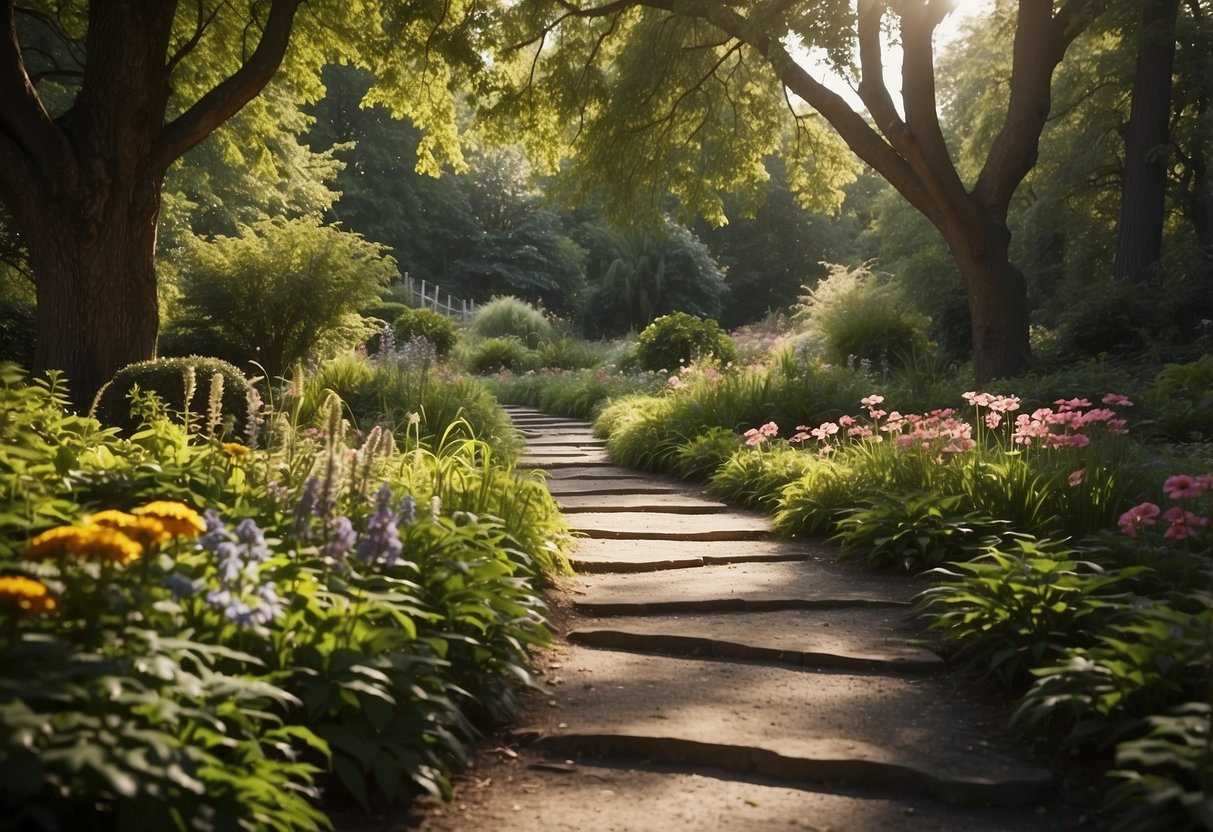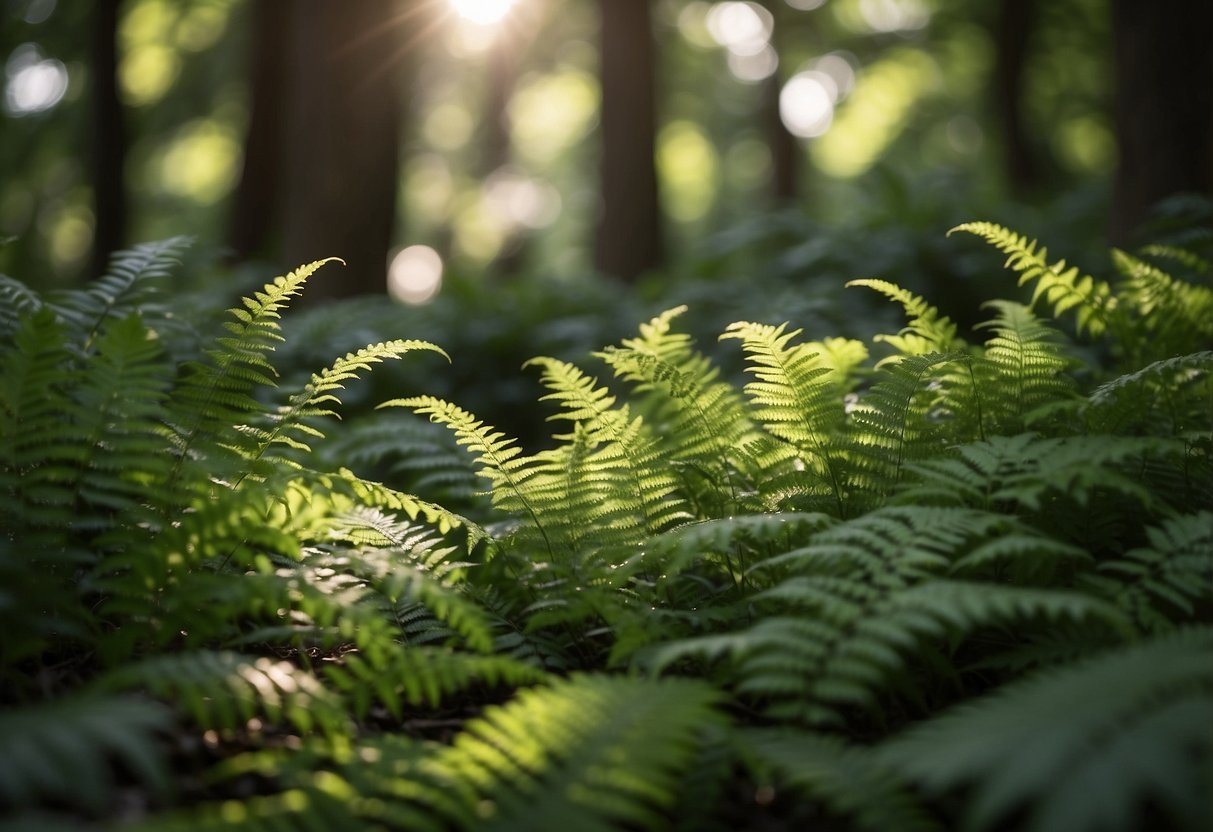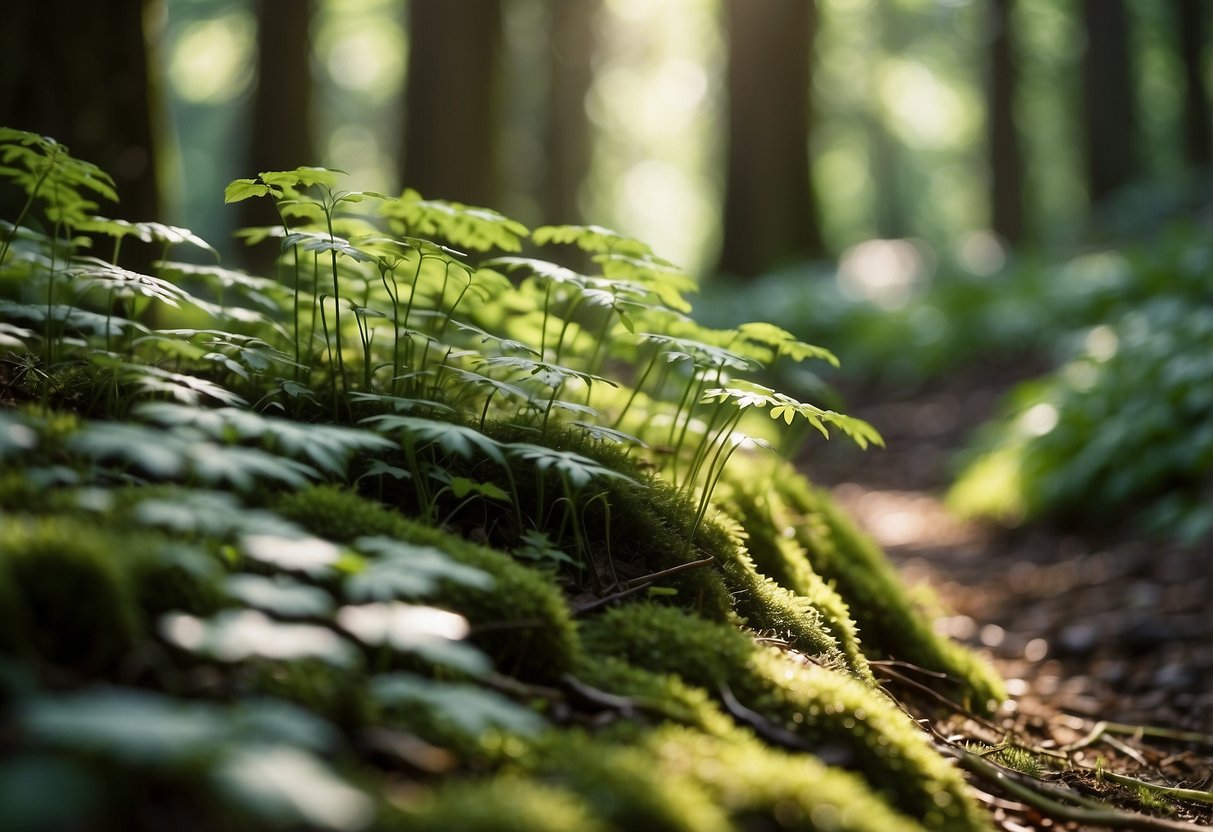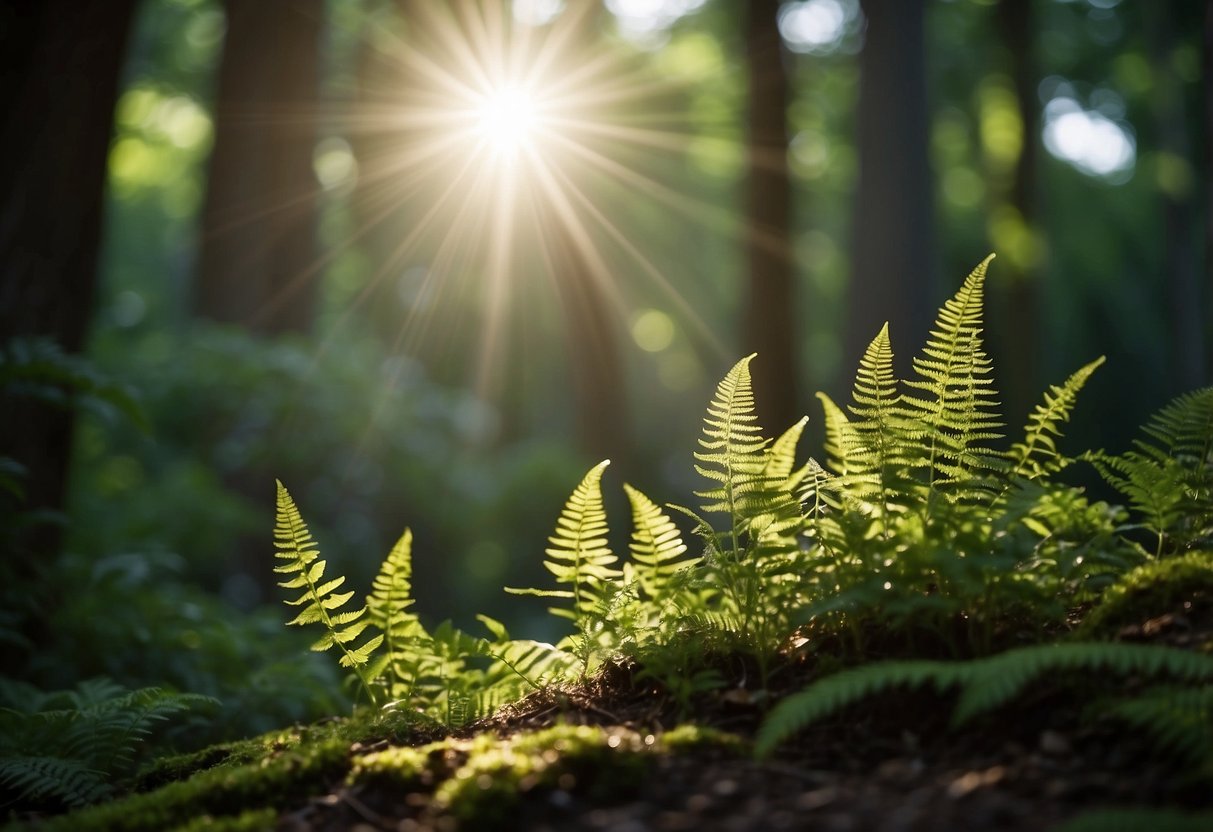Woodland Garden Ideas: Transform Your Yard into a Tranquil Oasis
Creating a woodland garden can transform your outdoor space into a peaceful and natural retreat. These gardens mimic the beauty of forests and thrive in shaded, moist areas. They support native plants and attract local wildlife, adding life to your backyard.

Wondering how to turn a shaded patch of your yard into a lush, green escape? Woodland gardens are perfect for those who love nature and want to enjoy a serene landscape without too much maintenance. With the right plants and a bit of planning, you can create a garden that flourishes in dappled sunlight.
1) Shade-loving Ferns

Creating a lush, green corner in your woodland garden is easy with shade-loving ferns. They bring elegance and life to those shady areas under trees.
You might enjoy adding the Soft Shield Fern with its upright fronds that gracefully arc as they grow.
For a bit of height, consider the Cinnamon Fern, which has tall, reddish-brown fronds in the center. These ferns are not just beautiful but also low-maintenance, making your garden space vibrant with minimal effort.
2) Woodland Wildflowers

Woodland wildflowers bring color and life to shaded gardens. You can include plants like Woodland Phlox, which have beautiful blue blooms and prefer partial shade.
Consider planting Astilbe, a pollinator-friendly flower that thrives in shady spots. They add texture and height to your garden.
Improve pathways in your garden with clean gravel, and build up the soil if it’s muddy to keep paths dry. Adding a bench in a favorite spot can make your garden more enjoyable.
3) Hellebore for Winter Blooms

Hellebores are a perfect choice for bringing color to your woodland garden in late winter. These hardy perennials can thrive in cold temperatures and often flower when other plants are dormant.
Plant your hellebores in rich, moist, but well-drained soil. They do best in spots with light shade, such as under deciduous trees or shrubs.
These beautiful flowers form evergreen clumps with serrate leaves. When temperatures drop below 15°F, the foliage may get damaged, but hellebores will resprout when cut back in spring.
For more tips on planting and caring for hellebores, visit Gardening Etc.
4) Bluebells for a Spring Display

Bluebells can transform your woodland garden in the spring with their charming blue-violet blooms. These plants are easy to grow and thrive in partially shaded spots with moist, well-drained soil. Their delicate, bell-shaped flowers add a magical touch to any garden.
To plant bluebells, place the bulbs 10-15 cm deep and 10 cm apart. This ensures they have enough space to grow and bloom beautifully. For the best results, plant them in the fall so they can establish roots before spring.
Bluebells are also very low-maintenance. Once planted, they require minimal care, making them perfect for beginner gardeners.
5) Native Grasses

Adding native grasses to your woodland garden helps create a natural, lush look. These grasses are hardy and often easy to maintain. Deer grass, or Muhlenbergia rigens, is an excellent choice. It grows up to 3 feet tall and has a striking appearance, adding vertical interest to your garden. Learn more about deer grass.
Indian grass is another notable option. It can reach heights of up to 8 feet, making a bold statement. These grasses also attract wildlife, enhancing the biodiversity of your garden. Explore ideas for landscaping with native grasses.
6) Hostas for Varied Foliage

Hostas are perfect for adding variety to your woodland garden. Their leaves come in many shapes and colors, making them a versatile choice.
You can find hosta leaves that are slender, rounded, heart-shaped, and more. This diverse foliage adds visual interest throughout your garden.
Consider planting hostas like the ‘Prairie Sky’ with its pale blue heart-shaped leaves. They can be a stunning focal point in any shady area.
7) Trillium for Delicate Blooms

Trilliums are delightful additions to your woodland garden. Known for their three-petaled blooms, they add a touch of elegance and charm. These flowers thrive in shady, moist areas.
To cultivate Trilliums, prepare a well-drained, moist seedbed in a shaded spot. Keep the soil consistently moist but not waterlogged.
Enjoy their subtle beauty each spring as they bloom into small, yet captivating flowers. For more tips on growing these lovely plants, visit this guide.
8) Heuchera for Leaf Color

Heuchera, also known as Coral Bells, is a fantastic choice for adding vibrant leaf color to your woodland garden. These plants are known for their colorful foliage that ranges from silver and black to shades of green, red, and purple.
You can enjoy different varieties like Obsidian Heuchera, which has stunning black leaves, or Heuchera Silver Scrolls, known for its shimmering silver leaves. Many heuchera varieties thrive in partial or full shade, making them perfect for woodland areas.
To keep your heuchera looking its best, plant them in well-draining, humus-rich soil. If you have darker-leaved varieties, they can even handle a bit more sun.
9) Solomon’s Seal for Graceful Arches

Solomon’s Seal is perfect for adding a touch of elegance to your woodland garden. With its arching stems that can grow up to 2 to 4 feet in height, it creates a graceful appearance.
This plant thrives in partial to full shade, making it ideal for shady areas of your yard. It’s easy to transplant, especially on a cool, overcast day in spring or fall.
Adding Solomon’s Seal brings texture and depth to any garden by reflecting dappled light beneath its leaves. The delicate sprays of flowers attract pollinators and blend seamlessly with other shade-loving plants. Learn more about growing and caring for Solomon’s Seal.
10) Tiarella for Foliage Patterns

Tiarella, or foam flower, is a perfect choice for adding interesting foliage patterns to your woodland garden. Its leaves often have unique designs, such as dark veins or spots. This adds visual intrigue even when the plant isn’t blooming.
Plant Tiarella in shady spots where it thrives. The plant’s leaves can turn bronze in winter, giving your garden year-round appeal. You might enjoy the striking change in color as seasons shift. This makes Tiarella a versatile addition to any garden.
For more information on how to grow and care for Tiarella, visit Epic Gardening or Garden Design.
Essential Elements of a Woodland Garden

Establishing a woodland garden involves selecting the right trees and shrubs, using native plants, and designing natural pathways.
Choosing the Right Trees and Shrubs
When creating a woodland garden, start with selecting trees and shrubs that thrive in shade or partial sun. Deciduous trees, like maples and oaks, are excellent choices. They provide a canopy and shed leaves in the fall, allowing more light during winter and early spring.
Layering is vital. Use taller trees for the upper canopy, smaller trees for mid-levels, and shrubs for the lower level. This creates depth and visual interest. Evergreen shrubs like rhododendrons add color year-round.
For a natural look, avoid planting in straight lines. Instead, group plants in irregular clusters. This mimics how they grow in the wild. Maintain variety in leaf shapes and colors to add texture and appeal.
Incorporating Native Plants
Native plants are crucial to the success of your woodland garden. They are adapted to your local climate and soil, making them easier to maintain. Native plants also support local wildlife, including pollinators.
Consider plants like ferns, wildflowers, and groundcovers that thrive in shade. Astilbe, for example, is a great choice for shady areas and attracts pollinators.
Research your region’s native plants and avoid invasive species. These can spread quickly and outcompete your native plants. Use a mix of flowering plants and grasses to create a balanced ecosystem that mimics natural woodland environments.
Creating Natural Pathways
Natural pathways guide you through your woodland garden and protect plant beds. Use materials like mulch, wood chips, or natural stone to create paths that blend seamlessly with the surroundings.
Paths can be winding or meandering. This not only adds charm but also helps you explore different parts of your garden. Keep the width of paths consistent and ensure they are easy to walk on.
Adding stepping stones or log slices can further enhance the natural feel. Also, consider elevating groundcovers like moss along the edges of pathways to create a lush, green border.
Creating these pathways will help make your woodland garden inviting and functional.
Design Techniques for Woodland Gardens

Creating a woodland garden involves techniques like layering plants at different heights, incorporating water features, and enhancing the space with groundcovers. These methods help achieve a natural and inviting look.
Layering with Different Plant Heights
Layering is crucial for a lush woodland garden. Start with tall trees as the backbone of your garden. Choose native trees that provide dappled shade, such as oaks or maples.
Mid-level shrubs come next. Think of species like rhododendrons or azaleas. These plants add texture and fill in the space between the ground and tree canopy.
Finally, use smaller plants and flowers at the ground level. Ferns, hostas, and wildflowers work well. This layered approach mimics natural forests and creates visual interest.
Using Water Features
Water features can bring tranquility to your woodland garden. A small pond or stream is ideal. It doesn’t have to be large, just enough to create a focal point.
Use natural materials like rocks and pebbles to line the pond. This helps it blend seamlessly into the surroundings. Add aquatic plants like water lilies to enhance the look and support local wildlife.
Consider adding a birdbath or a small fountain. These features add movement and sound, making the garden more dynamic and peaceful.
Enhancing with Groundcovers
Groundcovers are essential for maintaining a woodland garden. They prevent soil erosion and fill in bare spots. Choose plants that thrive in shady conditions, such as creeping thyme, periwinkle, or moss.
These low-growing plants help suppress weeds and retain moisture. They also add a lush, green carpet to the garden, enhancing its natural beauty.
Plant groundcovers in clusters for a more natural appearance. Vary the types to create a patchwork effect, and use them to define pathways or highlight specific areas in your garden. Consulting local gardening guides can offer more plant options suited to your region’s climate.
By following these design techniques, your woodland garden will become a serene and inviting retreat that closely mirrors the beauty of nature.
Maintaining Your Woodland Garden

Maintaining a woodland garden involves managing its soil, pruning and trimming plants, and controlling weeds naturally. These steps will keep your garden healthy and thriving.
Managing Soil Health
Healthy soil is crucial for a woodland garden. Start by testing your soil to understand its composition. You can use a home soil test kit to check pH levels and nutrient content. Most woodland plants prefer slightly acidic soil, with a pH between 5.5 and 6.5.
Organic matter enriches the soil. Add compost, leaf mold, or well-rotted manure to improve soil structure and fertility. Mulching is also important. Use organic mulch like wood chips or bark to retain moisture and suppress weeds.
Lastly, avoid disturbing the soil too much. Over-tilling can disrupt the beneficial fungi and microorganisms essential for plant health. Instead, gently mix in compost and mulch by hand.
Pruning and Trimming
Pruning helps control plant growth and maintains a neat appearance. For trees, avoid cutting branches larger than 2 inches in diameter to prevent damage. It’s best to limit pruning to no more than 15% of the tree’s foliage.
For shrubs, trim to maintain their shape and encourage healthy growth. Always use clean, sharp tools to make precise cuts. Focus on removing dead, diseased, or overcrowded branches.
Regular pruning also enhances light penetration and air circulation, which can reduce the occurrence of diseases. Remember, each plant type has a specific pruning season. Research the best times for trimming your specific plants.
Controlling Weeds Naturally
Weeding is vital to maintain a healthy woodland garden. Hand-pulling is effective, especially for young weeds. It’s best to weed after rain when the soil is moist.
Mulching is a natural weed deterrent. Apply a thick layer of organic mulch to prevent weed seeds from germinating.
Consider planting ground covers. Plants like ferns, hostas, and wildflowers can outcompete weeds by covering the soil and shading out weed seedlings.
Practicing these methods reduces the need for chemical herbicides, keeping your woodland garden eco-friendly and safe for wildlife.







